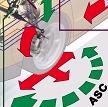 Most modern cars boast stability systems that can selectively brake road wheels and throttle back engine output if it seems that the car is out of control. Many can be partially or completely switched off by drivers who feel particularly skilled, particularly brave, or who have access to a race track and the cash for a new set of tyres, bumpers, bodywork, car, etc.
Most modern cars boast stability systems that can selectively brake road wheels and throttle back engine output if it seems that the car is out of control. Many can be partially or completely switched off by drivers who feel particularly skilled, particularly brave, or who have access to a race track and the cash for a new set of tyres, bumpers, bodywork, car, etc.
In most cars the steering is not a part of this electronic bag of safety tricks, but in the latest top-spec BMWs, that’s not the case.
Parts maker Continental is currently supplying BMW with a system that can alter the angle of the steered wheels to complement the efforts of the conventional stability components. It's available when buyers choose BMW's optional Active Steering.
To illustrate the difference, Continental uses the example of a car with its right-hand wheels on tarmac, and its left-hand wheels on ice - a situation that sounds a little contrived, but a great worst-case-scenario. Braking will tend to pull the vehicle around toward the side with the most grip, while accelerating will tend to push the car in the opposite direction. Normally, a driver will feel this and correct by steering against the pull.
However, during emergency braking, the different levels of grip will tend to cause problems for a conventional stability system. As ABS and ESP units step in, they will act to keep the car in a straight line by effectively steering the back wheels, by braking differently left and right. The result is that in an emergency, the car will tend to brake as if three out of four wheels are on ice, rather than just two. Obviously not a great leap forward in safety.
By adding electric motors to bring in a steering angle as required, even if the driver does nothing at the helm, Continental says it can get maximum braking effort out of all four wheels.
BMWs steer straight out of trouble
1 September 2005



